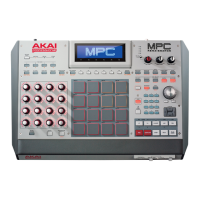274
Glossary
A lot of the terms in this manual are based on the MPC parameter names. This glossary briefly explains
many of the technical terms used throughout.
Aftertouch
The majority of contemporary keyboards are capable of generating aftertouch
messages. On this type of keyboard, when you press harder on a key you are already
holding down, a MIDI Aftertouch message is generated. This feature makes sounds
even more expressive (e.g., through vibrato).
Aliasing
Aliasing is an audible side effect arising in digital systems as soon as a signal contains
harmonics higher than half the sampling frequency.
Amount
Describes to which extent a modulation source influences a given parameter.
Amplifier
An amplifier is a component that influences the volume level of a sound via a control
signal. It can be modulated by a control signal (e.g., generated by an envelope or an
LFO).
Attack
An envelope parameter. This term describes the ascent rate of a time-relevant process
(e.g., an envelope from its starting point to the point where it reaches its highest value).
The Attack phase is initiated immediately after a trigger signal is received (e.g., after you
play a note on a trigger pad or a keyboard).
Bit Rate Bit rate (also known as Word Length), is the number of bits used to store the level
information of each single sample slice within a whole sample. The higher the bit rate,
the more precise the information about a sample (i.e., its dynamics' resolution). Normal
audio CDs use 16-bit. MPC supports full 24-bit resolution.
Clipping
Clipping is a sort of distortion that occurs when a signal exceeds the maximum value
that can be handled by a signal processing system it is fed into. The curve of a clipped
signal is dependent on the system where the clipping occurs. In the analog domain,
clipping effectively limits the signal to a given maximum level. In the digital domain,
clipping is similar to a numerical overflow, resulting in negative polarity of the signal's
portions exceeding the maximum level.

